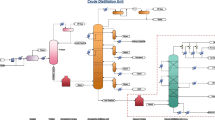Abstract
In this paper, the problem of flow maximization in pipeline systems for transmission of natural gas is addressed. We extend previously suggested models by incorporating the variation in pipeline flow capacities with gas specific gravity and compressibility. Flow capacities are modeled as functions of pressure, compressibility and specific gravity by the commonly-used Weymouth equation, and the California Natural Gas Association method is used to model compressibility as a function of specific gravity and pressure. The sources feeding the transmission network do not necessarily supply gas with equal specific gravity. In our model, it is assumed that when different flow streams enter a junction point, the specific gravity of the resulting flow is a weighted average of the specific gravities of entering flows. We also assume the temperature to be constant, and the system to be in steady state.
Since the proposed model is non-convex, and global optimization hence can be time consuming, we also propose a heuristic method based on an iterative scheme in which a simpler NLP model is solved in each iteration. Computational experiments are conducted in order to assess the computability of the model by applying a global optimizer, and to evaluate the performance of the heuristic approach. When applied to a wide set of test instances, the heuristic method provides solutions with deviations less than 10% from optimality, and in many instances turns out to be exact. We also report several experiments demonstrating that letting the compressibility and the specific gravity be global constants can lead to significant errors in the estimates of the total network capacity.
Similar content being viewed by others
References
Abbaspour M, Chapman KS (2008) Nonisothermal transient flow in natural gas pipeline. J Appl Mech 75(3):181–188. doi:10.1115/1.2840046
Bakhouya B, De Wolf D (2007) The gas transmission problem when the merchant and the transport functions are disconnected. HEC Ecole de Gestion de l’Université de Liége (ULG), Working paper 2007 01/01
Borraz-Sánchez C, Haugland D (2009) A tree decomposition algorithm for minimizing fuel cost in gas transmission networks. In: Proceedings of the 39th international conference: computers & industrial engineering (cie2009), pp 244–249. ISBN: 978-1-4244-4135-8
Borraz-Sánchez C, Ríos-Mercado RZ (2004) A non-sequential dynamic programming approach for natural gas network optimization. WSEAS Trans Syst 3(4):1384–1389
Borraz-Sánchez C, Ríos-Mercado RZ (2009) Improving the operation of pipeline systems on cyclic structures by tabu search. Comput Chem Eng 33(1):58–64
Carter RG (1998) Pipeline optimization: dynamic programming after 30 years. In: Proceedings of the 30th PSIG annual meeting, Denver, CO, USA
Chaczykowski M (2010) Transient flow in natural gas pipeline—the effect of pipeline thermal model. Appl Math Model 34:1051–1067
Crane Co (1982) Flow of fluids through valves, fittings and pipe. Technical paper 410, Metric Edition, USA
Davisson EG (1965) A computer program for flow calculations. Tech report ORNL-TM-1093, OAK Ridge National Laboratory, US Atomic Energy Commission, USA
De Wolf D, Smeers Y (1994) Mathematical properties of formulations of the gas transmission problem. SMG preprint 94/12. Tech report, Université Libre De Bruxelles
De Wolf D, Smeers Y (2000) The gas transmission problem solved by an extension of the simplex algorithm. Manag Sci 46(11):1454–1465
Dranchuk PM, Abou-Kassem JH (1975) Calculations of Z factors for natural gases using equations of state. J Can Pet Technol 14(3):34–36
Dranchuk PM, Purvis RA, Robinson DB (1974) Computer calculations of natural gas compressibility factors using the Standing and Katz correlations. Inst of Pet tech series, No IP-74-008, pp 1–13
GAMS Development Corporation (2008) GAMS: The solver manuals. Washington, DC, USA
Gopal VN (1977) Gas Z-factor equations developed for computers. Oil Gas J, Aug 8, 58–60
Kalvelagen E (2003) An improved formulation for a gas transportation problem. Scientific Literature Digital Library and Search Engine. doi:10.1.1.13.4509
Katz DL, Cornell D, Kobayashi R, Poettmann FH, Vary JA, Elenbaas JR, Weinaug CF (1959) Properties of natural gases and volatile hydrocarbon liquids. In: Handbook of natural gas engineering. McGraw-Hill, New York, pp 94–188. Chap 4
Modisette JL (2000) Equation of state tutorial. In: Proceedings of the 32nd annual meeting of pipeline simulation interest group (PSIG), Savannah, GA, USA
Murtaugh BA, Saunders MA (1983) MINOS 5.1 User’s guide. Tech report SOL-83-20R, Systems Optimization Laboratory, Stanford University, Stanford, CA, USA
Osiadacz AJ (1987) Simulation and analysis of gas networks. Gulf Publ, Houston
Ríos-Mercado RZ, Wu S, Scott LR, Boyd EA (2003) A reduction technique for natural gas transmission network optimization problems. Ann Oper Res 117:217–234
Shashi Menon E (2005) Gas pipeline hydraulics. CRC Press, Taylor & Francis, Boca Raton
Tawarmalani M, Sahinidis NV (2004) Global optimization of mixed-integer nonlinear programs: a theoretical and computational study. Math Program 99(3):563–591
Wong PJ, Larson RE (1968) Optimization of natural gas pipeline systems via dynamic programming. IEEE Trans Autom Control 13(5):475–481
Author information
Authors and Affiliations
Corresponding author
Rights and permissions
About this article
Cite this article
Borraz-Sánchez, C., Haugland, D. Optimization methods for pipeline transportation of natural gas with variable specific gravity and compressibility. TOP 21, 524–541 (2013). https://doi.org/10.1007/s11750-011-0210-z
Received:
Accepted:
Published:
Issue Date:
DOI: https://doi.org/10.1007/s11750-011-0210-z
Keywords
- Natural gas
- Compressibility factor
- Specific gravity
- Weymouth equation
- Transmission network
- Nonlinear optimization
- CNGA method



